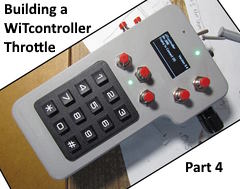........................... Return to Sumner's Home Page.
Return to N Scale RR Main Menu........ Return to DCC++ Menu....
…............…..... .
.. ============================================
It costs me a couple hundred each year to keep this site on the Internet.
===========================================================
..................--- WiTcontroller Throttle Menu ---
.....============================================
WiTcontroller is WiFi wireless throttle software designed by Peter Akers of EngineDriver fame. Using Peter's software and his parts list one can build a standalone wireless WiFi throttle that can connect to a wThrottle Server (JMRI, DCC-EX and many others). Peter has written the software and lists the parts needed to build the throttle ( HERE ) but it is up to you to come up with a case.
Below you will find a couple options regarding a case but you could also build your own. I'll also present two builds using the case that I designed and that you can print with print files up on thingiverse.com ( HERE ). The first build after the section on the case itself is the one I'd recommend following and should help even if you build your own case.
The WiTcontroller wasn't designed or built as a commercial venture but I believe that it is as good or better than most of the wireless throttles out there. Here are some of the main features if you build with the case shown or one similar.
…. A standalone wireless WiFi throttle that can connect to a wThrottle Server (JMRI, DCC-EX and many others).
…. The case is a good fit in ones hands and designed to be easily used.
…. You can assign up to 7 functions to the button switches on the case (your choice of which ones)
…. The keys on the keypad can also be assigned to ten functions of your choice.
…. You can also quickly toggle through 3 screens and toggle up to 28 functions (mostly sound) on and off.
…. Can choose locos by either the road number or via a roster if you have one setup.
…. Using the roster call-up it will also load the functions associated with that loco.
…. Can display up to 6 throttles running 6 locos or consists (toggle from one to the next by pushing the encoder)
…. Can throw turnouts and set routes.
…. Runs a long time on the battery and is easy to charge.
…. All of that and you can build the throttle for well under $50.
…. Being open source more features are being added all the time.
….........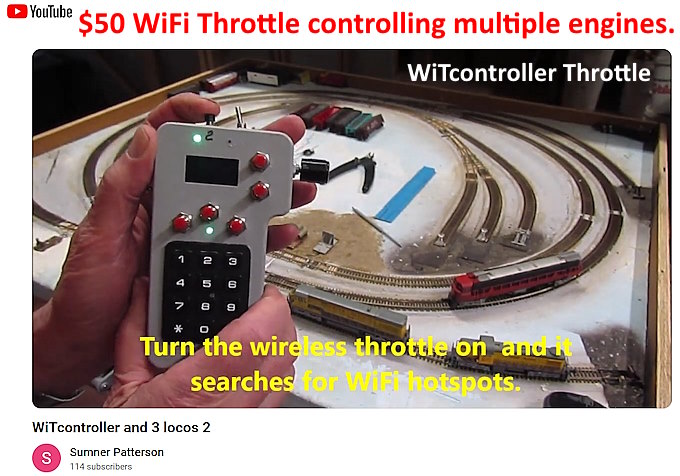
..................... …. Click on the image above or ( HERE ) to see the throttle in use.
======= About the WiTcontroller Throttle, Parts List & Print Files =======
Parts List & 3D Printed Case for Throttle (Pt. 1 & 2) ……….........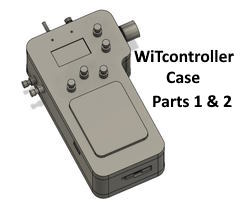
3D Printed Case for the WiTcontroller Throttle (Pt. 3) …...............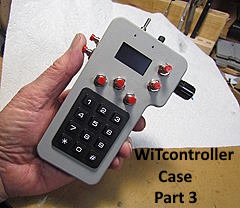
3D Printed Case Print files up on Thingiverse (Pt. 4) …...................
.....========== Building the Throttle with GPIO Inputs ===============
This throttle takes advantage of the GPIO inputs on the ESP32 and is more flexible in the controls and is easier to wire than the original one I did further down the page.
Building a WiTcontroller Throttle with GPIO Inputs (Pt. 1) ….....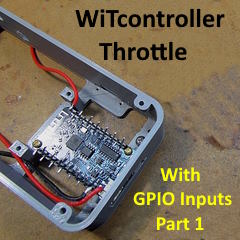
Building a WiTcontroller Throttle with GPIO Inputs (Pt. 2) ….....
Building a WiTcontroller Throttle with GPIO Inputs (Pt. 3) ….....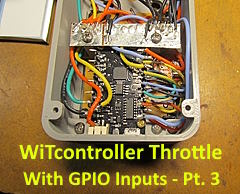
Building a WiTcontroller Throttle with GPIO Inputs (Pt. 4) ….....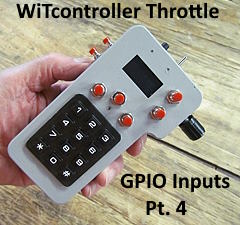
...=========== Building the Throttle Paralleling the Keypad ===========
NOTE: I'm going to leave this build option here a while longer in case someone has started down this road but........you really want to use the GPIO build option above here. Why....because with this option the external buttons mimic a key on the keypad. This means that the button can only execute a function that is assigned to a key. If you use the GPIO's as inputs keys can be assigned to functions and the buttons can be assigned to ones that are the same as a key on the keypad or an entirely different one. Mimicking the keypad with the buttons (this build) the maximum functions you can have is 10 (0-9) on the keypad. If you use the GPIO build (above here) you can assign 10 to the keypad and up to 7 more to the buttons. At the moment Peter has 16 available assignments to choose from along with 0-27 decoder functions (mostly sound functions) and Peter is adding more all the time. One last note...if you have already started this build paralleling the keypad it is easy to switch to the other one. I've done this with my first throttle that was build before the GPIO build was available.
============================
The first throttle I built I used this approach as Peter's software at the time didn't accommodate inputs to the ESP32. Now his software allow you to access up to 7 of the GPIO inputs on the ESP32 directly and has other advantages plus the wiring is simpler. I'm including it in case anyone started down this road and wants to continue down it. I'll be switching the throttle I have built this way over to the way the one above is build. Probably only take 30 minutes or so. If you have built a throttle along the following lines I'd recommend thinking about changing yours also.
Building a WiTcontroller Throttle (Pt. 1) …......................................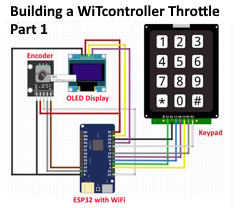
Building a WiTcontroller Throttle (Pt. 2) …......................................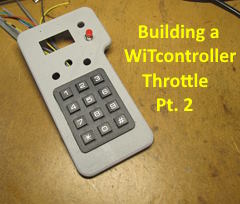
Building a WiTcontroller Throttle (Pt. 3) …......................................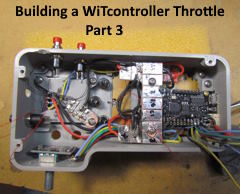
Building a WiTcontroller Throttle (Pt. 4) ….....................................